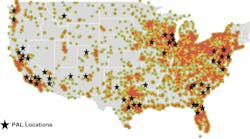The intermodal market received more good news for the second quarter of the year, as loadings for the U.S. and Canada were up 8% and 14.5%, respectively, over year-ago levels. Intermodal traffic on U.S. and Canadian railroads surged 8.8%, after climbing 5.7% in the first quarter. Most of the growth in trailer traffic during the second quarter can be attributed to U.S. trailer loadings, which rose 7.1%.
Preliminary numbers indicate that rail intermodal traffic has also been strong during the first few weeks of the third quarter. Container loadings have been robust, although trailer traffic took a hit as a result of the Teamsters strike at United Parcel Service.
During the first week of the strike, U.S. trailer traffic fell 3.2% from its level one year ago, after running consistently ahead of year-earlier totals for much of '97. During the strike's second week, traffic was down 4% from year-ago levels. Western trailer volume took the biggest hit, with declines of 6.4% and 6.9% during the two-week strike period. Trailer traffic in the East was off only 0.1% and 1.4%.
Overall, however, the UPS strike is not expected to have a major impact on intermodal loadings for '97. Cumulative trailer traffic fell only one-tenth of a percentage point during the strike, and most railroads anticipate that the lost business will be recouped this year.
Despite a rather sharp decline in consumer spending during the second quarter, the overall economic environment for freight transportation remained strong as businesses continued to build inventories. Stockpiles were increased at a $66.8-billion annual rate in the second quarter, after a $63.7-billion pace in the first quarter. To put this in perspective, inventories have climbed at a much more rapid pace through the first six months of 1997 than they did in late 1996. This, in turn, has helped fuel the strong demand for freight transportation providers.
Freight transportation demand also received a boost from strong merchandise trade. Exports rose to a record level in June, and imports were strong as well.
According to IANA's Intermodal Marketing Companies (IMCs) Market Activity Report, the growth in traffic levels for this sector, although solid, slowed somewhat during the second quarter from the strong pace set in the first quarter (20.9% and 25.6%, respectively).
Intermodal loads accounted for 50.2% of the total loads in this sector during the second quarter. This figure has declined steadily each quarter since the first quarter of '94, as IMCs continue to evolve into single-source logistics providers. The explosive growth of IMC highway truck business is evidence of the dynamic changes in distribution patterns occurring throughout the entire freight transportation industry.
As for the third quarter of '97, the first reports from IMCs have been far stronger than expected, suggesting that the second-quarter slowdown was only temporary. Consumers resumed their spending spree and the housing and labor markets remained vibrant.
While inflation is expected to remain in control in '97, price pressures may be mounting for '98. Any move by the Federal Reserve Board to increase interest rates, however, could temper economic growth and slow demand for freight transportation.
Since the economy is expected to maintain a moderate growth rate for the balance of the year, intermodal freight transportation demand should also remain strong throughout '97. With the holiday shipping season in full swing, low inflation and interest rates should continue to drive economic growth. The jump in consumer spending will create robust demand for freight transportation as depleted stockpiles are replenished.
Michael Arendes is director of policy and research for the Intermodal Association of North America (IANA).


